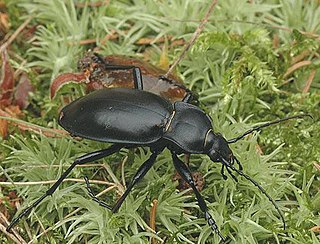
Carabus intricatus, the blue ground beetle, is a species of ground beetle found in Europe.

Carabus is a genus of beetles in family Carabidae. The genus is highly diverse with 91 subgenera and more than 1000 recognised species, thus is the largest genus in the subfamily Carabinae. The vast majority are native to the Palearctic, but 11 Nearctic species are also known. Carabus spp. are 12–50 mm (0.47–1.97 in) long, and most species are wingless and often very colourful. These are nocturnal, predatory beetles that feed on snails, earthworms, and caterpillars.

Carabus auronitens is a species of beetle in family Carabidae which was described by Johan Christian Fabricius in 1792.

Carabus smaragdinus is a species of beetle belonging to the family Carabidae.

Carabus excellens is a species of beetle endemic to Europe, where it is observed in Belarus, Moldova, Poland, Romania, central and southern Russia, and Ukraine.

Carabus violaceus, sometimes called the violet ground beetle, or the rain beetle is a nocturnal species of a beetle, from the family Carabidae.

Carabus gigas is a species of beetles of the family Carabidae.

Carabus problematicus is a species of beetle endemic to Europe, where it is observed in Andorra, Austria, Belgium, Great Britain, the Czech Republic, mainland Denmark, the Faroe Islands, Finland, mainland France, Germany, Hungary, Iceland, Ireland, mainland Italy, Latvia (doubtful), Liechtenstein, Luxembourg, mainland Norway, Poland, Romania, northern and northwestern Russia, Slovakia, Slovenia, mainland Spain, Sweden, Switzerland, and the Netherlands.
Hervé de Toulgoët was a French entomologist. He specialised in moths of the families Arctiidae and Zygaenidae. He also studied the beetle genus Carabus. He was written about by Paul Thiaucourt and Jocelyne Navatte.

Carabus blaptoides is a species of ground beetle in the family Carabidae that can be found in Japan and Russia. The species are black coloured, but could have either purple or green pronotum.
Carabus exiguus is a species of black-coloured ground beetle in the Carabinae subfamily that is endemic to China.

Carabus hummeli is a species of ground beetle in the subfamily Carabinae that can be found in Russia and the eastern Palearctic realm. The species are brown coloured with blue pronotum. They also can be found in such Asian countries as China, Mongolia, and North Korea.

Carabus lineatus is a species of beetle in the family Carabidae that can be found in France, Portugal, and Spain. The species is black in colour with grey wings and legs.
Carabus marietti is a species of ground beetle in the Carabinae subfamily that can be found in Bulgaria, European part of Turkey, and Near East.
Carabus obsoletus is a species of black-coloured beetle from family Carabidae, found in Czech Republic, Hungary, Moldova, Romania, Slovakia, Ukraine.

Carabus sylvestris is a species of either black or brown-coloured ground beetle in the Carabinae subfamily that can be found in Austria, Czech Republic, Hungary, Italy, Liechtenstein, Poland, Romania, Slovakia, Slovenia, Ukraine, and the Netherlands.
Carabus albrechti is a species of either black or brown coloured ground beetle in the subfamily Carabinae that is endemic to Japan.

Albunea carabus is a rare species of "sand crab" or "mole crab" in the genus Albunea. It lives in shallow, turbulent waters in sandy areas of the tropical eastern Atlantic Ocean and the Mediterranean Sea.

Carabus maeander is a species of beetle in the family Carabidae. The species fly in May and June, are black in colour and 15 to 23.5 millimetres long. It is found in northeastern United States and both central and southern Canada. The species is also found outside of North America. In Russia, it is found in eastern Siberia while in Japan it is known from Hokkaido and Kunashir Islands. It also exists in South Korea.













